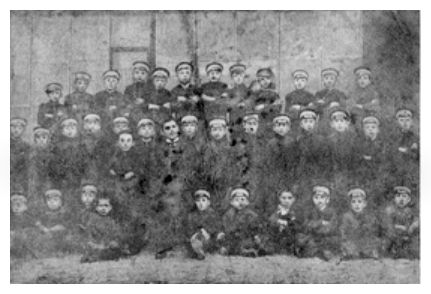
In center – the teacher Bogdanski
|
by Dovid Kan
Translated by Gloria Berkenstat Freund
Several influences flowed together through the general cultural life of the
Jewish population of Radomsk. In every era these influences flowed and adjusted
[themselves] to the time and to the character of organized society.
In the olden times, when our holy seforim (holy books) filled the Beis Midrashim (houses of study) and Yeshiva, they were the main source [and influence] from which the first generation drew its spiritual nourishment. Although individual Radomskers already were receiving a secular education, too, they received it in another town. Radomsk proper was then a relatively small community with great limitations. In the surrounding environment, the Polish population was a big majority with a lower level of cultural development.
Thus it was until the end of the 19th century. The Russian government, which then ruled in Poland, began to carry out various reforms in the existing Jewish khederim (traditional Jewish schools). The melamdim (traditional teachers) had to follow the sanitary regulations and had to teach in the Russian language. At that time, too, the so-called “state public school” was introduced.
The first Jewish school employed Mr. Golomb [as the teacher] (for the boys) and 'Mrs.' Funem Dentist Rozenblat [as the teacher] (for the girls). The school occupied one big room and [in it] was taught Russian, arithmetic, geography etc, all [taught] in Russian. Once a month (Friday) the cantor Shlomoh Zaks would come and teach singing (naturally, the Russian Imperial Hymn: “Bozhe Tzarya Khrani” came first). The school observed Yiddishkeit and was closed on Shabbos. During a Russian “galawke” the children went with the teacher into the school.
[At that time] in Radomsk there were also private (religious) teachers: the Lelewer teacher, the Warszawer teacher and others. At that time, there also existed a Polish school and a pre-gimnazye [headed by] Mr. Fachan, which had a dormitory. The school of the gimnazye had enrollees from the surrounding Polish property owners. (Apparently some Jewish children with wealthy parents studied there, too.) Some young Jewish girls also studied in the Polish middle school, which was called the “Pension” [headed by] Mrs. Marszantowicz (Later it was headed by Fräulein Khamitszuwne). Other Jewish children studied in neighboring towns such as Częstochowa, Piotrkow and elsewhere.
 |
| The Jewish “Folks Shul” in 1908
In center – the teacher Bogdanski |
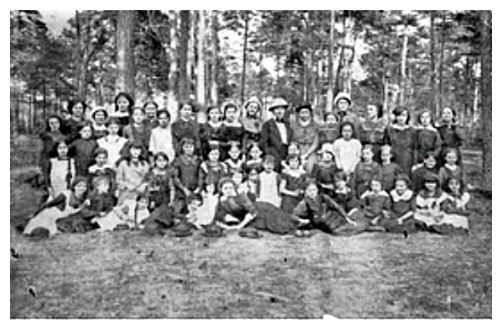 |
| The teachers and female students
from Miss Khamitszuwne's Girls “Gimnazye” in 1914 The first from the right: Polja Fajerman-Goldberg |
[Page 252]
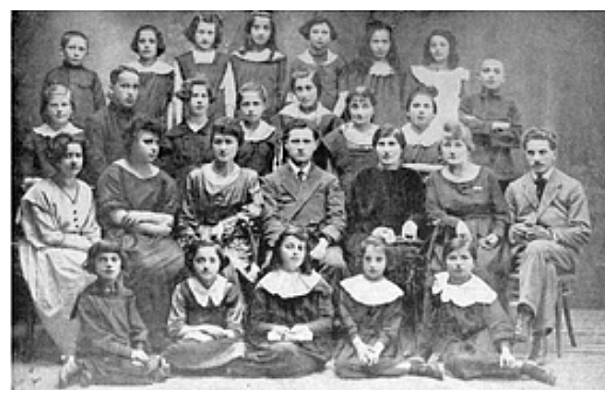 |
| 1918 – Teacher and students of the Jewish State “Folks-Shul,”
under the direction of Haim Krajndler (in center). On the right-Mrs. Krajndler-Wisotski [Translator's note: The translator's mother Tema Gliksman Berkenstat is in the second row from the top, fifth from the left.] |
It is self-evident that the Enlightenment movement also had its adherents among
the younger generations in the yeshivas and Beis Hamidrash and
among the older generation, too. In addition the old Hebrew Press and the
national [publishers] Pinsker, Lilienblum, Ached-hem and others,
had readers among the Jewish intellectuals of other circles in Radomsk.
The distinguished Yiddish author and poet Hersh Dovid Nomberg (1876-1927) had at one time left the Gerer shtibel in Radomsk and settled in Warsaw (a short time later he published his first [writings]).
The Socialistic-Revolutionary movement of 1905-6 gave a big push to the flow of cultural accomplishments and to Yiddish [accomplishments], in particular. Unfortunately, this did not last long, because with the brutal oppression of the revolution all slogans and aspirations were suppressed. Their [proponents] were either assassinated, or sent to distant Siberia, or emigrated to the other, free[r] countries.
The state school with [its] Russian language [requirements] continued to exist. Instead of Mr. Golomb who had left Radomsk, the teacher Bogdanski became the head of the school, naturally, with a complete program change. The youths [of 18 and 19], that remained in the town after the revolutionary storm, looked for various ways to maintain a cultural life. In several towns in Poland, Jewish cultural institutions were created such as “literary societies,” Hazamir and so forth. In Radomsk Hazamir was also created [with] a wide cultural [mandate]. The famous conductor Mr. Benisman and the old artistic leader Mr. Gelbart were brought in to lead the choir. Under the artistic leadership of Mr. Benisman, the opera “Di Yidn” was given its first performance in Hebrew. At the same time [drawing on] the strength of local musicians a symphonic orchestra was created. Under the leadership of Mr. Klewanski, who was the conductor of the Russian military orchestra, which had been stationed in Radomsk, the State Orchestra developed very well and its opening concerts echoed far, far from Radomsk.
With the outbreak of the First World War (in 1914), when the Czarist power was expelled from Poland, the new political regime of the German-Austrian occupation diminished pressure on societal life, mainly in the cultural sphere. There was an opening of wider horizons for an educational and cultural revival among the Jewish population. The young organized a culture-circle (at first illegally) and created the organization “Kultura” which organized lectures and readings, creating a large library of Yiddish and Polish books (actually the first Jewish library in Radomsk) and a drama circle, too. Separate evening courses for adults [were given] under the direction of [a] student Gobrish Winer.
In 1916 Krajndler returned home to Radomsk [and] developed the Jewish Folks-Shul with instruction in Polish. Mr. Krajndler together with his wife (née Wisotski) developed the Folks-Shul with a nationalist spirit, naturally, in so far as the legal opportunities permitted.
At the same time, the Jewish [political] Parties came back to life, especially the workers' parties, such as the “Poalei-Zion” and “Zeiri-Zion” (Z. S.), later [called] the “Fareinikte,” and the “Bund” and the like. The bourgeois streets became lively again [with] the “Mizrakhi,” and, later “Agudas Yisroel” and “Zeiri-Shumi Amunas Yisroel.” Each party, especially the workers' parties, carried on broad [liberal] cultural work. In a short time, the workers' parties co-founded “Kultura.” At the [same] time the other party [opened] its own meeting hall with a library, a dramatic section and [a place] where readings and lectures would be organized, not only on political themes, but on general and cultural themes [as well]. The workers' parties founded the first [experimental] children's home (in the house of Shammai the tinsmith, Krakowski 7), which was later named after the worthy Dr. Mitelman (children from the poor homes were educated in the children's home).
During the [First] World War (1916) the Mizrakhi Party was founded
(later a Mizrakhi School). The leaders were: Mr. Frenkel, Mr. Waksman,
Mr. Najmerk, Reuven Liberman, Shlomoh Rabinowicz, Szitenberg and others.
Together with a group from the general socialistic leadership, they were
concerned that the Mizrakhi School stand on a high level of
achievement, pedagogically and nationally. The leader of the school
movement B. Karmazin assembled the best educational staff,
locally and from other towns.
[Page 253]
A library of Hebrew seforim was opened in the school which were
available not only to talmidim (students) for school, but for
everyone who wanted to read a Hebrew religious book. The Mizrakhi
School was properly the first national school and it gathered together
students from all sections of the Jewish population.
The Agudas Yisroel founded its own school under the name “Yesod'd Hatorah” (Basics of Torah) (in Shul Street in the house of Bezaleel Kalka). The school espoused “traditional Masora education (system of critical notes to the scriptural text) and [taught] subjects with a great deal of Hebrew” and had [in its employ]: a Hebrew teacher (Tenenbaum); teachers of Polish (Epsztajn and Koniecpolski). The first school head was Mr. Brumer from Zawiercie. In the later years, a religious middle school “Beis Yakov ” was also established. Both religious schools of “Agudas Israel ” offered a religious or a secular education.
The general Zionist organization created at its location (in Ferszter's school which was named the “Beis Yakob ” school) a big library of Hebrew books, and lectures and readings by Zionist leaders were held there.
In the twentieth year of the century a private school was founded as the Erlikhman's school, [using the] Hebrew language [for instruction], in which ten juveniles received a nationalistic and Hebrew [-centered] upbringing,
D. Czaszczewatzki, who came to Radomsk with the Jewish refugees whom the German army had evacuated from Belarus in the First World War, opened a Hebrew private school with Hebrew educators and with Zionist concerns. This school was active (of course, in secret) even in the period of the Second World War.
In the past M. Z. Rosenblum had opened his modern [style] kheder where the subjects were taught in Modern Hebrew.
Right after the First World War, Miss L. Wajntrojb (of Piotrkow) opened the first Jewish gimnazye, using the Polish language for instruction. Modern Hebrew was also taught. The gimnazye, which [followed] an entirely new high pedagogy, attracted the strongest and best teachers.
The young [students] in the gymnazyes [studied] the [required] subjects and were not required to attend the Polish middle school. At one time, two gimnazyes existed in the city-[one run by] Fabian Zhelinski, and [one run by] Mr. Niamec (in Czenstohowa Street, near Mulik Felcer). In the first year, the Jewish students who studied there were influenced by the teaching staff, which held lectures and readings on different scholarly and cultural themes. In later years, the gimnazye of Mr. Niamac consisted of eight grades and was known as one of the best middle schools in the city.
Furthermore, libraries existed for virtually all of the Jewish parties. In 1924 the Artisan's Organization opened a large library with Yiddish and Polish books which was named after Y.L. Peretz. The rightist Poalei Zion – “Zion will prevail” united with Z.S. [and] in 1926 opened a library under the name of Sholom Aleichim. Besides Yiddish and Polish books, the library also contained a large section with Hebrew seforim which were sent by friends in Eretz-Yisroel. The last librarian of this Library was subsequently a ghetto-fighter in Warsaw, Tuvia Borzykowski. In the first year of the war (1940) he had hidden a large part of the Hebrew religious books (seforim) in the attic of the Library and after the war the seforim served the remnant which [returned] from the lager, bunkers and forests.
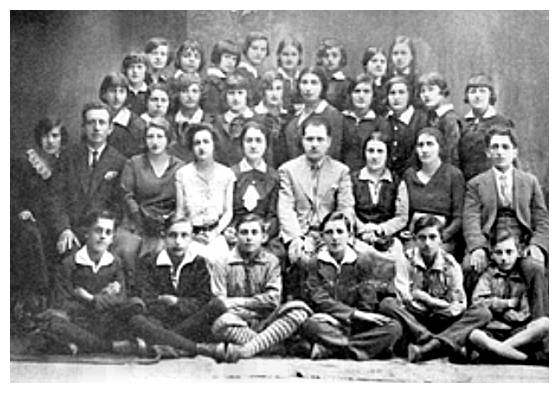 |
| In the school year 1931/32 Teaching staff
Top: In the school year 1931/32. Teaching staff (from the right):
Bottom: The first Hebrew School in 1918. Established by Dovid Erlikhman.
|
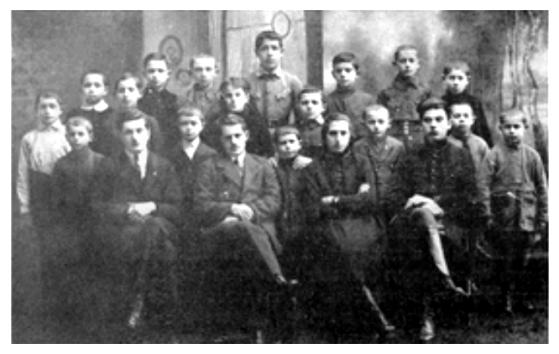 |
| The first Hebrew school in 1918 |
[Page 254]
The rightist Poalei-Zion (with Z. S.) created a Folks University where the very
distinguished Prof. Bromberg read lessons and gave lectures on scientific themes.
The leftist Poalei-Zion created its evening courses where Yiddish and Polish, etc. subjects
were studied (They also created a library under the name of Ber Borochov).
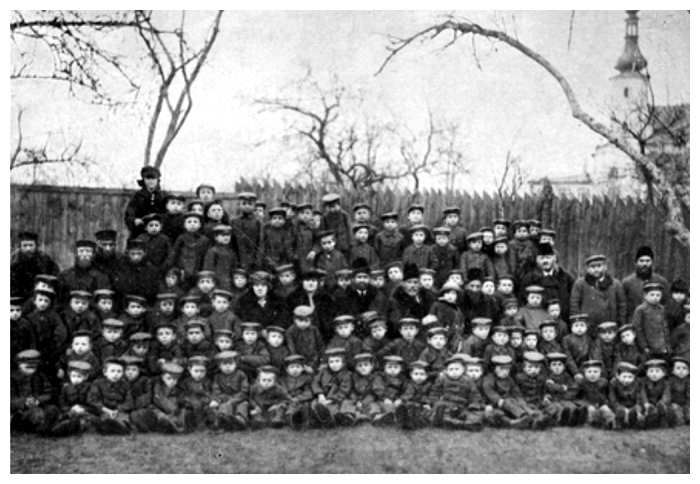 |
| At the conclusion of the clothing distribution to “Talmud Torah”
children, (Winter 1922)
The committee (from the right): A. Yosef
Rozenblat, Shlomoh Gliksman, Yakob Rozenbaum, Ahron-Wolf Szwarc,
|
In the 30th year of the century, the well-to-do Jews created a larger
Talmud Torah for poor children, where they were given food and clothing
in addition to an education. The management consisted of Berish Gonszerowicz,
Yakov Rozenbaum, Shlomoh Gliksman, A. Yosef Rozenblum, and others, [under
the leadership] of Rabbi Reb Izrael Pinkhas Hacohan Rabinowicz. They had no
difficulty in [funding] the institution for the needy (the Radomsker landsleit
in America supported the Talmud Torah, in particular the [generous]
donor Mr. Sol Grinberg).
The wide spectrum of Zionist organizations and groupings [were important] in helping to support the cultural ascent of the city.
[Neighboring] villages were mentioned in the local newspaper “Radomsker Life” which was published [as a supplement] to the Yiddish newspaper of Piotrkow. The Radomsker of “Radomsker Lebn,” Mr. Wolkowicz, a well-known worker for the Zionist cause and distinguished friend of “Confederation,” edited the newspaper with a nationalist and Zionist spirit over the course of ten years. The newspaper was a driving force and guidebook not only for political and economic development but, [particularly with] cultural publications for the Jewish population.
Herr Zeligfeld (the son of Reb Borukh-Mordekhai, the scribe) was a constant contributor to the Yiddish newspapers of Warsaw and Częstochowa under the pen name “Herr Zeligfeld.” In Radomsk he published an occasional periodical “Der Radomsker Shpigel” with a special satiric style in which Jewish life was featured with all its difficulties and achievements.
In “Der Zeit,” the Czentochower weekly, [there was] at certain
times a Radomsker supplement under the name “Radomsker Zeit,”
which relected local Jewish life.
[Page 255]
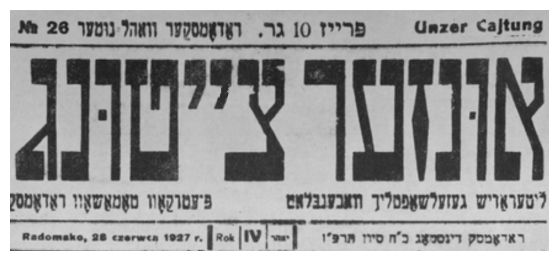 |
| “Undzer Zeitung” |
It is necessary here to remember the Karafke family, which during the period of
ten score years was the promoter of the Yiddish press in Radomsk. The writer of
these lines remembers very well that the first books he read he had bought from
the Karafke family at a very small [cost] (There were not yet at that time any
libraries in Radomsk).
One of the most famous painters Herr Horowicz (a brother of the photographer) lived in Radomsk. He had long studied in Italy, France and Germany and his special interest was in [the study of the] paintings of famous artists like Leonardo di Vinci, Michaelangelo and Rafael.
Before the Second World War, the Jewish painter Nathan Szpigel lived and worked in Radomsk [where he] organized several exhibitions and took part in local Jewish communal work.
A[n important] chapter for me was the Jewish sports unions in which the Jewish youth “straightened their backs” and bravely competed with Polish youth. The slogan of the Zionist movement leader, Doctor Max Nordau, “In a healthy way one can develop a healthy soul,” had [just as great an] appeal for Jewish youth in Radomsk [as it did in the rest of the] world. And the “Radomsker Zeitung” hailed the occasion of a Lag b'Omer celebration of the Jewish sport unions in 1926:
“...a feeling of internal and external freedom must have dominated every nationalist thinking Jew, who spent Saturday evening and Sunday morning going through streets, from “Hokoakh” “Makabee” and “Hashomer Hatzair.…” One remembers the Lag b'Omer excursion of twenty years ago by our kheder [students], with their hunched little shoulders [and] how they were afraid of the smallest sheigetsl (gentile boy), or [of] a bark from a little dog.
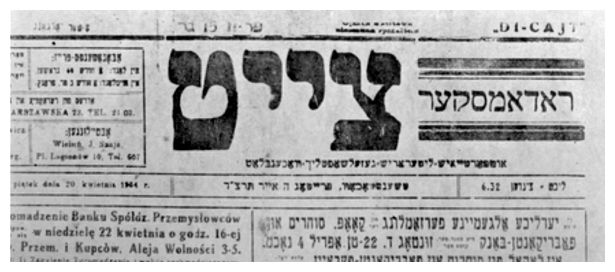 |
| “Radomsker Zeit” |
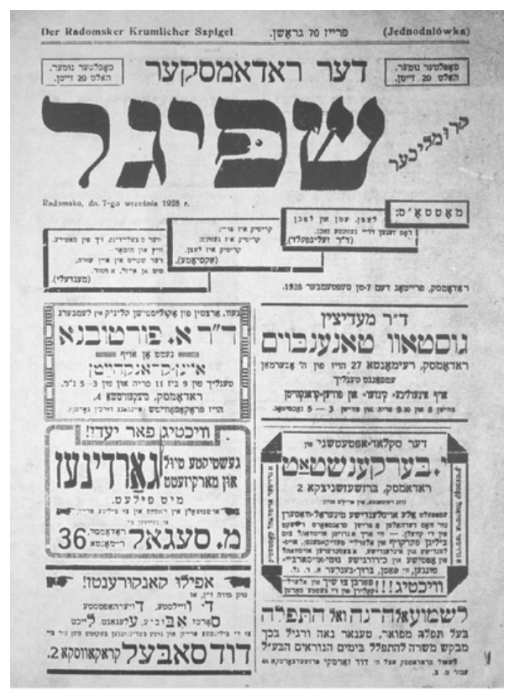 |
| “Der Radomsker Shpigel” |
Now we see a marching, proud Jewish youth, full of cheer and fight, with shoulders
[thrown back] and chests [thrust] forward, which was [good] for scaring a dog or a
sheigetsl… Thus we were again bound together, after two centuries
of [having been ripped away] from the connection to our grandfathers, the
heroes of Bar Kokhba and Makabees… Sports training
for the Jewish Youths was not supported by any national or state budget,
but consistently by the Jews alone.”
Advertisements from Der Radomsker Krumlikher Shpigel, Friday, 7th September 1928:Doctor of Medicine Gustav Tenenbaum
Doctor A. Portubna, Eye Illnesses
M. Segal
Dovid Sobel
|
[Page 257]
In a second spot in the newspaper we read further:
“On Shabbos on Strzalkowski Street, the sports-club, Hokoakh gathered near the Jewish gimnazye, with their cycling and football (soccer) sections, [together with] the Makabee [athletes]. [They were preceded by] a baton race to the accompaniment of an orchestra, which marched through the streets: Strzalkowski, Kaliska, Powiatowa and others… On Sunday morning [there was] an excursion of the above-mentioned union and of the Hashomer Hatzair. The gathering place was again at the Jewish gimnazye, from where the parade marched over the streets with an orchestra and later left on a march to Kaminsk... This was an emotional experience of the Jewish Sports Union, particularly the marchers from Hashomer Hatzair, and attracted hundreds of curious [people], not only Jews, but also Christians who accompanied the march of the proud Jewish youths.”
The Jewish Sports Club Poalei Zion, alone among all of the sports sections, possessed its own orchestra, under the [leadership] of Nathan Ofman.
Step by step, rung by rung, Jewish Radomsk created its educational and cultural institutions with local character. They [joined] with and were absorbed by the general Jewish cultural world of pre-war Polish Jewry and left traces [of] footprints over [the] paths and roads of the larger Jewish world which was annihilated together with Polish Jewry [by the] Hitlerist gangs.
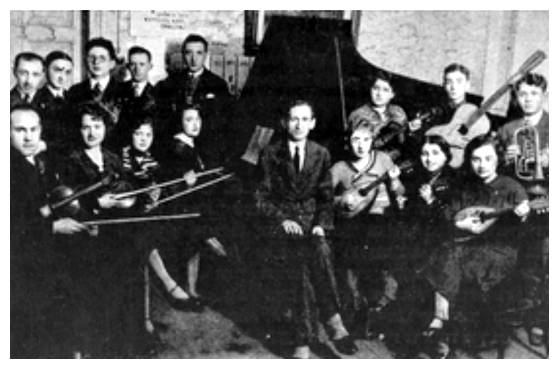 |
| The “Poalei Zion” Orchestra in 1933
Sitting (from the right): Manye Szpira, Truskolaski, —, Malka Szpira,
Director Natan Ofman,
Standing: Hilel Rozencwajg, Yurbaski, Haim Hartman, Dawidowicz, Dovid-Meir
Kornberg |
|
JewishGen, Inc. makes no representations regarding the accuracy of
the translation. The reader may wish to refer to the original material
for verification.
JewishGen is not responsible for inaccuracies or omissions in the original work and cannot rewrite or edit the text to correct inaccuracies and/or omissions.
Our mission is to produce a translation of the original work and we cannot verify the accuracy of statements or alter facts cited.
 Radomsko, Poland
Radomsko, Poland
 Yizkor Book Project
Yizkor Book Project
 JewishGen Home Page
JewishGen Home Page
Copyright © 1999-2025 by JewishGen, Inc.
Updated 13 Oct 2024 by LA